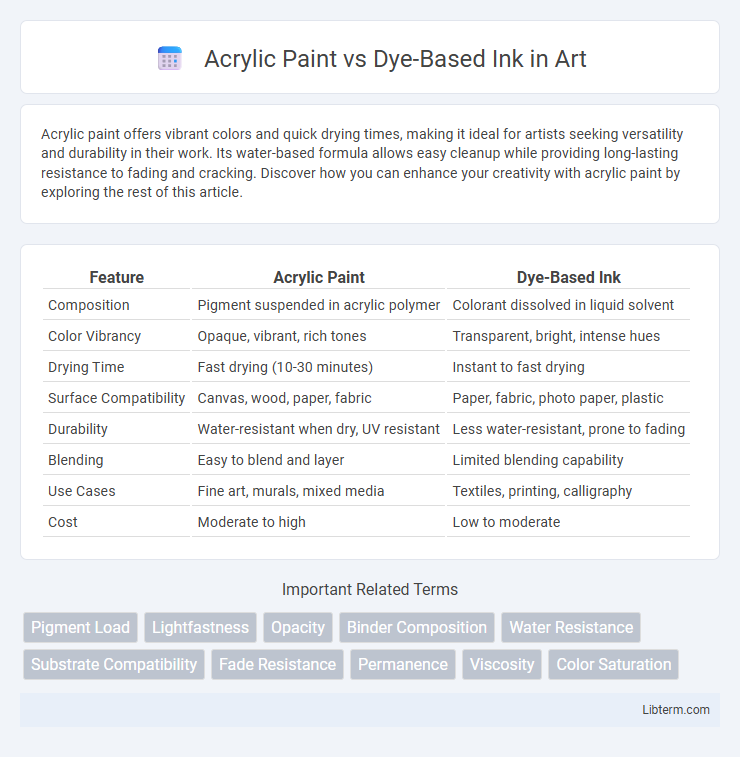Acrylic paint offers vibrant colors and quick drying times, making it ideal for artists seeking versatility and durability in their work. Its water-based formula allows easy cleanup while providing long-lasting resistance to fading and cracking. Discover how you can enhance your creativity with acrylic paint by exploring the rest of this article.
Table of Comparison
| Feature | Acrylic Paint | Dye-Based Ink |
|---|---|---|
| Composition | Pigment suspended in acrylic polymer | Colorant dissolved in liquid solvent |
| Color Vibrancy | Opaque, vibrant, rich tones | Transparent, bright, intense hues |
| Drying Time | Fast drying (10-30 minutes) | Instant to fast drying |
| Surface Compatibility | Canvas, wood, paper, fabric | Paper, fabric, photo paper, plastic |
| Durability | Water-resistant when dry, UV resistant | Less water-resistant, prone to fading |
| Blending | Easy to blend and layer | Limited blending capability |
| Use Cases | Fine art, murals, mixed media | Textiles, printing, calligraphy |
| Cost | Moderate to high | Low to moderate |
Introduction to Acrylic Paint and Dye-Based Ink
Acrylic paint consists of pigment suspended in an acrylic polymer emulsion, offering vibrant colors and durability on various surfaces such as canvas, wood, and fabric. Dye-based ink, composed of soluble colorants dissolved in a liquid base, provides bright, transparent hues ideal for paper and lightweight materials. Acrylic paint dries quickly to a water-resistant finish, whereas dye-based ink remains more susceptible to fading and water damage over time.
Composition and Chemical Properties
Acrylic paint consists of pigment particles suspended in an acrylic polymer emulsion, making it water-resistant and flexible when dry, whereas dye-based ink contains soluble dyes dissolved in a liquid carrier, resulting in vibrant colors but less resistance to water and fading. The polymer matrix in acrylic paint forms a durable film upon drying, providing strong adhesion and longevity, while dye-based inks lack this polymer structure, leading to quicker absorption into substrates and potential bleeding. Chemically, acrylics rely on synthetic polymers derived from acrylic acid or methacrylic acid, whereas dye inks use organic dye molecules that chemically bond with paper fibers but remain more susceptible to environmental degradation.
Color Vibrancy and Longevity
Acrylic paint offers superior color vibrancy due to its high pigment concentration and opaque finish, making colors appear rich and intense. It provides excellent longevity, as it is resistant to fading, water, and UV exposure, ensuring artwork remains vibrant over time. Dye-based ink, while bright and vivid initially, tends to fade more quickly and is less durable on porous surfaces, limiting its long-term vibrancy.
Surface Compatibility
Acrylic paint adheres well to a wide variety of surfaces including canvas, wood, metal, and plastic due to its thick, pigmented consistency. Dye-based inks penetrate porous surfaces such as fabric and paper, offering vibrant colors but limited durability on non-absorbent materials. Surface compatibility is crucial when choosing between acrylic paint and dye-based ink, as acrylic's versatility suits diverse projects while dye-based ink excels in textile and paper applications.
Drying Time and Curing Process
Acrylic paint typically dries to the touch within 15-30 minutes but requires 24-48 hours to fully cure, ensuring durability and resistance to water and UV damage. Dye-based ink dries quickly on porous surfaces, often within seconds to minutes, but lacks a curing process, making it more susceptible to smudging and fading over time. The curing stage in acrylic paint enhances adhesion and permanence, whereas dye-based ink's rapid drying prioritizes immediacy over long-term durability.
Water Resistance and Durability
Acrylic paint offers superior water resistance and long-term durability compared to dye-based ink, which is more prone to fading and smudging when exposed to moisture. Acrylic's polymer composition creates a waterproof barrier that adheres well to various surfaces, ensuring vibrant and lasting color retention. In contrast, dye-based inks, composed of soluble colorants, are water-soluble and tend to run or wash away, making them less suitable for outdoor or high-moisture applications.
Application Techniques
Acrylic paint offers versatile application techniques such as brushwork, palette knife, and sponge, allowing for textured and layered finishes on various surfaces including canvas, wood, and fabric. Dye-based ink excels in precision applications like calligraphy, stamping, and detailed illustrations, providing vibrant, translucent colors that absorb quickly on porous materials like paper and textiles. Both mediums require specific preparation methods; acrylic paint benefits from primed surfaces to enhance adhesion, while dye-based inks perform best on untreated or specially coated substrates to prevent bleeding and maintain color sharpness.
Creative Uses and Project Ideas
Acrylic paint offers vibrant colors and thick texture ideal for canvas, wood, and fabric projects, making it perfect for bold murals, textured artworks, and mixed-media crafts. Dye-based ink provides a translucent finish and excellent absorption, best suited for paper crafts, calligraphy, and fabric printing with intricate designs and gradients. Combining both materials in projects like altered books or fashion customization enhances visual depth and creative versatility.
Environmental Impact and Safety
Acrylic paint contains synthetic polymers that are less prone to leaching toxic chemicals into the environment, making it relatively safer for outdoor use and disposal compared to dye-based ink, which often contains hazardous solvents and heavy metals. Dye-based inks can pose greater environmental risks due to their water solubility and potential to contaminate water sources, impacting aquatic life and ecosystems. Acrylic paint's low volatile organic compound (VOC) emissions contribute to improved indoor air quality, enhancing user safety during application.
Choosing the Right Medium for Your Art
Acrylic paint offers vibrant colors and durability, making it ideal for textured, layered artwork that requires longevity and water resistance. Dye-based ink provides brilliant transparency and smooth blending, perfect for detailed illustrations and paper crafts where brightness and precision matter. Selecting the right medium depends on your project's surface, desired finish, and archival needs--acrylic suits canvas and mixed media, while dye-based ink excels on absorbent papers and textiles.
Acrylic Paint Infographic

 libterm.com
libterm.com